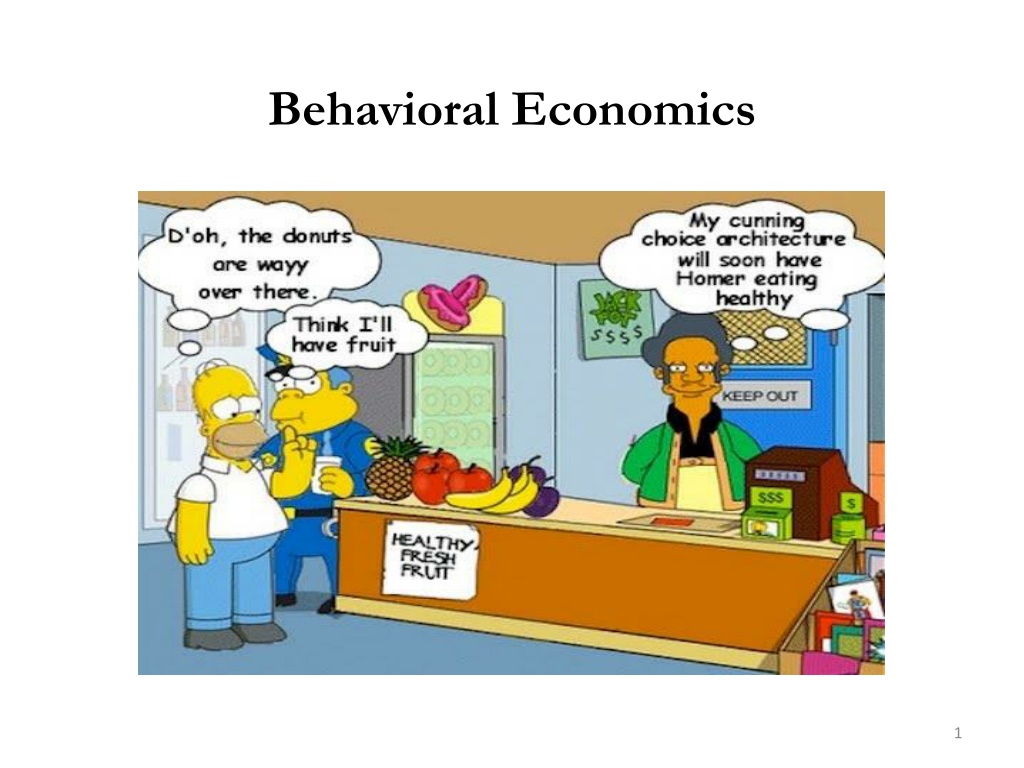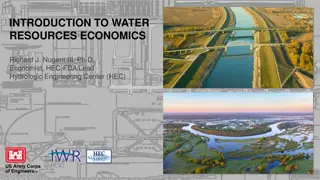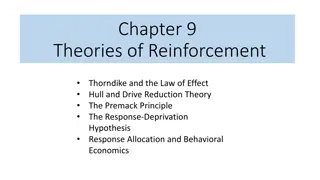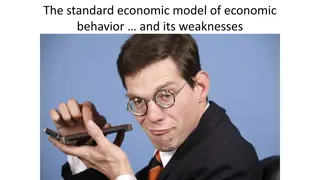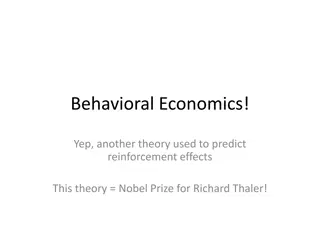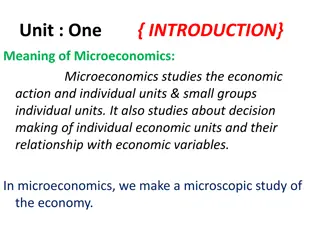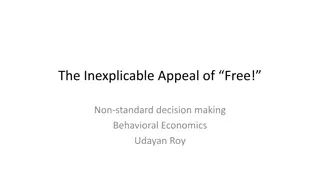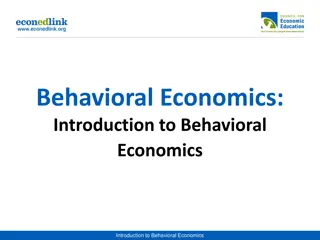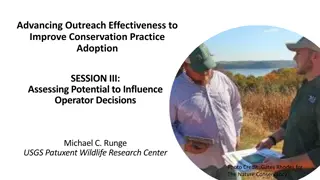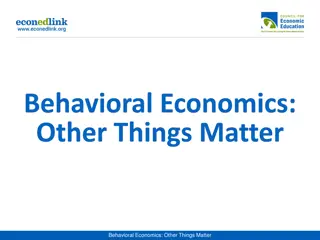Understanding Behavioral Economics and Decision Making
Behavioral economics challenges the traditional rational agent model by incorporating insights from psychology into economic behavior analysis. This approach reveals systematic biases and departures from rational decision-making, leading to a better understanding of why people make certain choices. Through framing experiments like the ones in the introduction exercise, we see how the presentation of choices can significantly influence decision outcomes. By identifying these biases, behavioral economics enhances our ability to create more accurate economic behavior models and predictions.
Download Presentation

Please find below an Image/Link to download the presentation.
The content on the website is provided AS IS for your information and personal use only. It may not be sold, licensed, or shared on other websites without obtaining consent from the author. Download presentation by click this link. If you encounter any issues during the download, it is possible that the publisher has removed the file from their server.
E N D
Presentation Transcript
Behavioral Economics The model of economic behavior we have considered in this course is restrictive in a number of ways Economic agents are assumed to be perfectly rational Agents are assumed to perfectly understand risk and uncertainty Agents are assumed to be self-interested In reality, people exhibit a number of departures from this rational agent model of decision making Behavioral economics Branch of economics that incorporates insights from human psychology into models of economic behavior Used to help us understand why our models may not make the predictions we think they should in some cases. 2
Introduction Exercise You work for Centers of Disease control and you need to keep American safe. There is a sudden and usually flu-like disease that breaks out. Your best estimate is that 600 Americans will die from the disease if no government action is taken. You are given a choice between 2 programs to address the crisis: Pick what you would do for each program. There are 2 possible responses to the crisis for each program and each cost the same amount, but can only choose one due to resource constraints. 3
Introduction Exercise Program 1: Response A will save 200 people. Response B is risky. It has a one-third chance to save all 600 people but a two-thirds chance to save no one. Which do you choose? 4
Introduction Exercise Program 2 Response C 400 people will die for certain. Response D there is a one-third chance that no one will die and a two-third chance that everyone will die. Which do you choose? 5
Introduction Exercise The framing was different in the two programs but the content for each choice in a program the same. Consistent response was A and C, or B and D Experiment, 73% picked response A for program 1 while 78% choose response D for program 2. Why? Framing. By manipulating how alternatives were framed researchers could alter choices dramatically. 6
Behavioral Economics Behavioral economics is concerned with systematic departures from rational choice Behavioral economists attempt to identify systematic biases Departures from rational choice can inform the development of more general, descriptive models of economic behavior Models can be used to develop testable hypotheses and predict economic behavior 7
When Human Beings Fail to Act the Way Economic Models Predict Some systematic departures from rational choice are: Bias 1: Generosity and Selflessness Bias 2: Paying Attention to Sunk Costs Bias 3: Overconfidence Bias 4: Self-Control Problems and Hyperbolic Discounting Bias 5: Falling Prey to Framing introduction example 8
Bias 1: Generosity and Selflessness Economic model of rational choice assumes rational self- interest, many people often engage in acts of generosity and exhibit altruism Acts motivated primarily by a concern for the welfare of others Donations to charity are the most obvious example Economists have tried to include this in the model for example by addition someone else s consumption into your utility function. Parent s utility depends on child s consumption 9
Bias 2: Paying Attention to Sunk Costs We learned sunk costs do not matter for economic decision making. Rational decision makers think at the margin and only consider opportunity costs. Sunk Cost Fallacy: However, in reality people are influenced by sunk costs in their decision making. 1985 Experiment: randomized how much people paid for seasons tickets to Ohio University Theater ($9, $13, $15). If the the sunk cost doesn t matter (price of ticket) then the percent of people who go to the show from each group should be the same. But it wasn t. Those who paid more were 25 percent more likely to go than those who got a discount. Businesses or gov t can make similar mistakes by keeping on implementing a project that is way over cost and they can t afford even though they may be just 10 percent into the project and would be better of abandoning the project. 10
Bias 3: Overconfidence Individuals believe their skill level and judgment are better than they truly are, or they expect that outcomes are better for them are more likely to happen then they truly are. Numerous studies have shown that humans tend to overestimate positive attributes about themselves In one survey, 93% of college students said they were better than average drivers On a popular dating website, 73% of individuals describe themselves as having very good or better than average physical attractiveness 11
Bias 3: Overconfidence Problem: our models assume people have a realistic expectations and base their decisions on facts. Company managers confident in their own abilities maybe more inclined to make bigger investments and take on more risk in the overconfident view they will succeed. How Economic Markets Take Advantage of Overconfident People Firms take advantage of overconfidence Consider gym memberships: Why do gyms charge monthly memberships instead of per-visit fees? Individuals who sign up for a health club tend to be far too optimistic about the prospects of sticking to their exercise goals Health clubs tailor their offerings to exploit such over optimism Charging monthly fees allows health clubs to extract surplus from over- optimistic clients 12
Bias 4: Self-Control Problems and Hyperbolic Discounting People have a strong preference for NOW A 10% discount rate implies that $1.00 today is equivalent to $0.90 next year There is evidence that many people have a much higher discount rate when making decisions about immediate consumption Hyperbolic discounting Tendency of people to place much greater importance on the immediate present than even the near future when making economic decisions 13
Bias 4: Self-Control Problems and Hyperbolic Discounting Problem: Decisions stop being time-consistent Consistencies in a consumer s economic preferences in a given economic transaction, whether the economic transaction is far off or imminent When consumers are not time-consistent, they will, for instance, specify their preferred exercise and diet routine for next week now, but then when they get to next week, they won t want to stick with the plan they set up 14
Does Behavioral Economics Mean Everything We ve Learned Is Useless? While the rational-choice model is not perfect, it does an excellent job of predicting human behavior in many circumstances This model can often be generalized or otherwise extended to account for behavioral anomalies Provides a basis for thinking about seemingly irrational behavior, often illuminating rational motivations (e.g., conspicuous charitable donations that improve reputation) Regardless of individual behavior, markets tend to be coldly rational Exposure to markets has been shown to reduce the presence of biased actors and/or behavior 15
Testing Economic Theories with Data: Experimental Economics The evidence from psychology and behavioral economics has placed an even greater emphasis on the importance of testing economic models with real data However, analyzing economic decisions in the real world is very difficult. In response, two subfields of economics have emerged as leaders in the evaluation of economic models: econometrics and experimental economics Econometrics: Field that develops and uses statistical and analytical techniques to test economic theory Experimental economics: Branch of economics that relies on experiments to illuminate economic behavior These two fields have helped turn economics into a more evidence-based science 16
